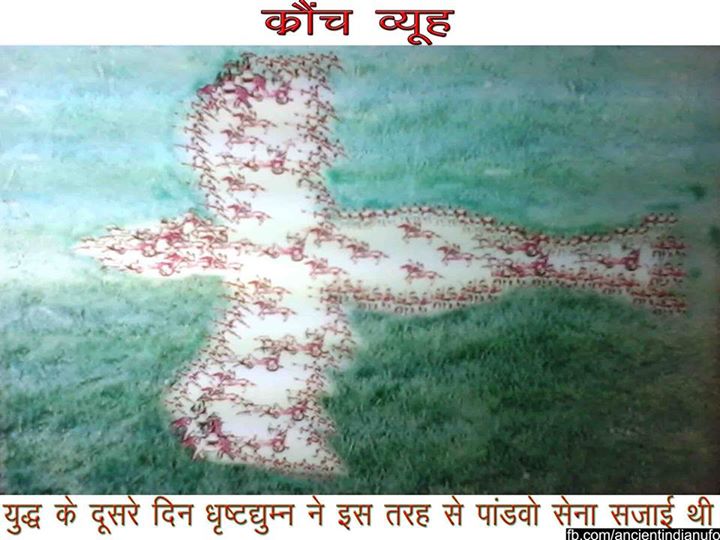|
25/10/17
 |   | ||
SUNDAY, 9 DECEMBER 2012
சக்கரவியூகம்
மகாபாரதத்திலிருந்து இன்னும் ஒரு தகவலை இங்கு பதிவு செய்ய விரும்புகிறேன். அது என்னவென்றால் துரோணர் அமைத்த சக்கரவியூகம். இதைப் புரிந்துகொள்வதற்கு சில வலைத்தளங்களையும், புத்தகங்களையும் படித்தேன். அதை தமிழில் உங்களுக்குப் புரியும் படியாக எழுத முயற்சி செய்திருக்கிறேன்.
 போரில் பங்கு பெற்ற அத்தனை வீர்ர்களையும் அக்செளகினி (Akshauhini) என்று அளவிட்டார்கள், ஒரு அக்செளகினியில் 21,870 ரதங்கள், 21,870 யானைப் படை, 65,610 குதிரைப் படை, 1,09,350 காலாட்ப் படை வீர்ர்கள் இருப்பார்கள். மொத்தமாக பாரதப் போரில் 18 அக்செளகினி இருந்ததாக கூறப்படுகிறது. (7 பாண்டவர்கள் பக்கமும், 11கெளரவர்கள் பக்கமும்). இவர்கள் மொத்தமாக 48x128 சதுர கிலோ மீட்டர் பரப்பளவில் இருந்தார்கள். இந்த சக்கரவியூகம்அமைக்க இதுவே போதுமானதாக இருந்திருக்கும்.
போரில் பங்கு பெற்ற அத்தனை வீர்ர்களையும் அக்செளகினி (Akshauhini) என்று அளவிட்டார்கள், ஒரு அக்செளகினியில் 21,870 ரதங்கள், 21,870 யானைப் படை, 65,610 குதிரைப் படை, 1,09,350 காலாட்ப் படை வீர்ர்கள் இருப்பார்கள். மொத்தமாக பாரதப் போரில் 18 அக்செளகினி இருந்ததாக கூறப்படுகிறது. (7 பாண்டவர்கள் பக்கமும், 11கெளரவர்கள் பக்கமும்). இவர்கள் மொத்தமாக 48x128 சதுர கிலோ மீட்டர் பரப்பளவில் இருந்தார்கள். இந்த சக்கரவியூகம்அமைக்க இதுவே போதுமானதாக இருந்திருக்கும்.
 இது 7 சுற்றுக்களாக அமைந்திருக்கிறது. வெளிச்சுற்றில் இருப்பவர்கள் வலிமை குறைந்தவர்களாகவும், உள்ளே செல்லச்செல்ல வலிமை மிக்கவர்களாகவும் எண்ணிக்கையில் அதிகமாகவும் இருப்பார்கள். இதன் உள்ளே செல்லும் வீரனின் நிலைமையை இப்போது எண்ணிப்பாருங்கள்…
இது 7 சுற்றுக்களாக அமைந்திருக்கிறது. வெளிச்சுற்றில் இருப்பவர்கள் வலிமை குறைந்தவர்களாகவும், உள்ளே செல்லச்செல்ல வலிமை மிக்கவர்களாகவும் எண்ணிக்கையில் அதிகமாகவும் இருப்பார்கள். இதன் உள்ளே செல்லும் வீரனின் நிலைமையை இப்போது எண்ணிப்பாருங்கள்…

இந்த முறையை பயன்படுத்தி ஒரு சில சுற்றுக்கள் உள்ளே எளிதாகச் செல்ல முடியும், ஆனால் உள்ளே செல்லச் செல்ல எதிரிவீர்ர்கள் பலம் மிக்கவர்களாகவும் அதிக எண்ணிக்கையிலும் இருப்பார்கள். ஆகையால் ஒரே நேரத்தில் பல வீர்ர்களைக்கொன்றால் தான் உள்ளேச் செல்ல வழி கிடைக்கும்.
அர்ஜீனனுக்கு மட்டுமே தெரிந்ததாலும், அபிமன்யு வஞ்சகமாக கொல்லப்பட்டதாலும், இது முக்கியமான இடத்தைப் பிடிக்கிறது. அப்படி என்ன தான் துரோணர் அதில் புதுமை செய்தார் என்பதைக் காணலாம்.
 போரில் பங்கு பெற்ற அத்தனை வீர்ர்களையும் அக்செளகினி (Akshauhini) என்று அளவிட்டார்கள், ஒரு அக்செளகினியில் 21,870 ரதங்கள், 21,870 யானைப் படை, 65,610 குதிரைப் படை, 1,09,350 காலாட்ப் படை வீர்ர்கள் இருப்பார்கள். மொத்தமாக பாரதப் போரில் 18 அக்செளகினி இருந்ததாக கூறப்படுகிறது. (7 பாண்டவர்கள் பக்கமும், 11கெளரவர்கள் பக்கமும்). இவர்கள் மொத்தமாக 48x128 சதுர கிலோ மீட்டர் பரப்பளவில் இருந்தார்கள். இந்த சக்கரவியூகம்அமைக்க இதுவே போதுமானதாக இருந்திருக்கும்.
போரில் பங்கு பெற்ற அத்தனை வீர்ர்களையும் அக்செளகினி (Akshauhini) என்று அளவிட்டார்கள், ஒரு அக்செளகினியில் 21,870 ரதங்கள், 21,870 யானைப் படை, 65,610 குதிரைப் படை, 1,09,350 காலாட்ப் படை வீர்ர்கள் இருப்பார்கள். மொத்தமாக பாரதப் போரில் 18 அக்செளகினி இருந்ததாக கூறப்படுகிறது. (7 பாண்டவர்கள் பக்கமும், 11கெளரவர்கள் பக்கமும்). இவர்கள் மொத்தமாக 48x128 சதுர கிலோ மீட்டர் பரப்பளவில் இருந்தார்கள். இந்த சக்கரவியூகம்அமைக்க இதுவே போதுமானதாக இருந்திருக்கும்.
இது ஒரு வட்ட வடிவமான புதிர் (வியூகம்), இந்த வியூகம் சுற்றிக்கொண்டே இருக்கும். அதனால் தான் சக்கரவியூகம் என்று துரோணர் கூறியிருக்கிறார்.
 இது 7 சுற்றுக்களாக அமைந்திருக்கிறது. வெளிச்சுற்றில் இருப்பவர்கள் வலிமை குறைந்தவர்களாகவும், உள்ளே செல்லச்செல்ல வலிமை மிக்கவர்களாகவும் எண்ணிக்கையில் அதிகமாகவும் இருப்பார்கள். இதன் உள்ளே செல்லும் வீரனின் நிலைமையை இப்போது எண்ணிப்பாருங்கள்…
இது 7 சுற்றுக்களாக அமைந்திருக்கிறது. வெளிச்சுற்றில் இருப்பவர்கள் வலிமை குறைந்தவர்களாகவும், உள்ளே செல்லச்செல்ல வலிமை மிக்கவர்களாகவும் எண்ணிக்கையில் அதிகமாகவும் இருப்பார்கள். இதன் உள்ளே செல்லும் வீரனின் நிலைமையை இப்போது எண்ணிப்பாருங்கள்…
உள்ளே செல்லும் வீரன் சக்கரவியூகத்தின் பாதையை உருவாக்கி மையத்திற்குச் சென்று அங்கு எல்லோரையும் கொன்று விட்டால், மையம் அழிந்து சக்கரவியூகம் உடைந்துவிடும். ஆனால் சுற்றிக்கொண்டிருக்கும் சக்கரவியூகத்தின் எதிரி வீர்ர்கள் அதன் வாயிலை மூடிவிடுவார்கள், அதனால் உள்ளே சென்ற வீரன் மாட்டிக்கொள்வான்.
கீழே உள்ள படங்களைப் பாருங்கள், உள்ளே வரும் வீரன் ஒரே இடத்தில் தான் நிற்கிறான், ஆனால் சுற்றிக் கொண்டிருக்கும் எதிரி வீர்ர்களுக்கு இடையில் தான் எங்கு நிற்கிறோம், எங்கு செல்ல வேண்டும் என்பதையே கண்டுபிடிக்க முடியாதபடி திணறிவிடுவான்.

சற்று சிந்தித்துப் பார்த்தால், உள்ளே வந்த வீரன், உடனடியாக 4ம் சுற்றில் உள்ள எதிரியுடன் போரிட வேண்டும். இப்போது இதன்பிரம்மாண்டத்தை உங்களால் உணரமுடிகிறாதா?.
சக்கரத்தின் சுற்றுக்களில் உள்ள ஒரு வீரன் கொல்லப்பட்டாலும், அவனின் வலது புறம் உள்ள இன்னொருவன் அந்த இடத்திற்குவந்துவிடுவான். வியூகத்தின் உள் சுற்றுக்களில் அதிக வீர்ர்கள் குவிந்திருப்பதால், ஒரு வீரன் இறந்து விட்டாலும், அவன்இடத்தை நிரப்புவது பெரிய விசயம் அல்ல. இப்படியாக சக்கரம் முழுவதும் சுற்றிக்கொண்டே உள்ளே வந்த வீரனை துவம்சம்செய்துவிடும்.
உள்ளேச் செல்லும் வீரன், எல்லோரும் நினைப்பது போல் தன் எதிரில் உள்ள ஒருவனை கொன்றுவிட்டு முன்னேறஎண்ணினால், அதற்குள் கொல்லப்பட்ட வீரனின் வலதுபுறம் இருக்கும் வீரன் அந்த இடத்தை நிரப்பி விட தன் இடது புறமாகவந்துவிடுவான்.
இப்படியாக வட்டதில் உள்ள ஒவ்வொரு வீரனும் சுற்றிக்கொண்டே இருப்பார்கள், உள்ளே செல்லும் வழியே அகப்படாமல்திணறிக்கொண்டிருக்க வேண்டும். இதன் சுற்றளவும் மிகப் பெரியதாக இருப்பதால், உள்ளே வந்த வீரன் சுற்றிச்சுற்றியேகளைத்தும் போய்விடுவான்.
.
இப்போது அபிமன்யு என்ன செய்தான் என்று பார்ப்போம். (படிக்கும் உங்களுக்கு எதேனும் தோன்றுகிறதா?)
எல்லோரும் போல் அல்லாமல், தனக்கு முன்னால் உள்ள வீரனை விட்டு விட்டு, ஒரே நேரத்தில் இரண்டு பேர்களைக் கொல்லவேண்டும். அந்த இரண்டு இடத்தை நிரப்புவதற்கு கொல்லப்பட்டவர்களின் வலது புறத்திலிருந்து வீர்ர்கள் வருவார்கள், இப்போதுபாருங்கள், அபிமன்யு விற்கு நேராக ஒரு வழி கிடைத்துவிட்டது.
இந்த முறையை பயன்படுத்தி ஒரு சில சுற்றுக்கள் உள்ளே எளிதாகச் செல்ல முடியும், ஆனால் உள்ளே செல்லச் செல்ல எதிரிவீர்ர்கள் பலம் மிக்கவர்களாகவும் அதிக எண்ணிக்கையிலும் இருப்பார்கள். ஆகையால் ஒரே நேரத்தில் பல வீர்ர்களைக்கொன்றால் தான் உள்ளேச் செல்ல வழி கிடைக்கும்.
அதே சமயம் சக்கரம் சுற்றிக்கொண்டே இருப்பதால், மிக கவனமாகச் செல்ல வேண்டிய மையத்தை நோக்கியே எண்ணம்இருக்க வேண்டும். (இப்போது அர்ஜுனன் பறவையின் கண் மட்டுமே தெரிகிறது என்று துரோணரிடம் கல்வி கற்கும் போதுசொன்னது நினைவில் வருகிறதா?) இது ஒருவனின் அறிவிற்கும், ஆற்றலுக்குமான சவால்.
போர்க்களத்தில் இந்த சவாலை வெற்றிகொள்ள பாண்டவர்களின் பக்கம் மூன்று பேருக்கு மட்டும் தான் தெரியும். (கிருஷ்ணர்,அர்ஜுனன் மற்றும் அபிமன்யு, இதில் அபிமன்யுவிற்கு வெளியே வரும் வித்தை தெரியாது.)
அபிமன்யு உள்ளே சென்றதும், பின் தொடர்ந்து பாண்டவர்களில் அர்ஜுனனைத் தவிர்த்து மற்ற நால்வரும் சென்றனர். ஆனால்சக்கரவியூகத்தின் விதிமுறைப்படி அபிமன்யு உள்ளே வந்த உடன், சுற்றுகளில் இருக்கும் வீர்ர்கள் வழியை மறைத்து விட்டனர்.அபிமன்யு மட்டும் உள்ளேச் சென்றுகொண்டே இருந்தான், இதனால் அவன் வஞ்சகமாக கெளரவர்களால் கொல்லப்பட்டான்.
ஒரே நேரத்தில் பல எதிரிகளை கொல்லும் திறமை ஒரு சிறந்த வில் வீரனுக்குத்தான் (இங்கு, அபிமன்யு) உண்டு. அதனால்தான் மற்ற பாண்டவர்களால் உள்ளே செல்ல முடியவில்லை.
Thanks to all references (web site & books). Because of you, I explained this for my tamil understanding peoples.
இதன் கல்வெட்டு
Anonymous 10 December 2012 at 00:09
wonderful post.... fullla padichen
Reply
Anonymous 10 December 2012 at 22:26
You can refer in English
URL: http://www.quora.com/
Tamil Book: Mahabharatham by Srimath Swami Sithbhavananthar
Reply
ஹரன்பிரசன்னா 19 December 2012 at 04:32
Good one.
Reply
Anonymous 19 December 2012 at 05:48
இந்தக் கல்வெட்டு எங்கு உள்ளது ?
-ஸ்ரீனி
Reply
Muthu Raman 19 December 2012 at 21:51
Srini, No idea about kalvettu. But it may be in Kurukshetra city in Haryana.
http://parotasalna.blogspot.
மகாபாரதம் அபிமன்யு போர் வியூகம் போர்த்தந்திரம் புராணம்
Question merged
You were redirected because this question was merged with What was the right strategy for Abhimanyu to defeat the Padmavyuha formation from the Mahabharata?
33 Answers
















